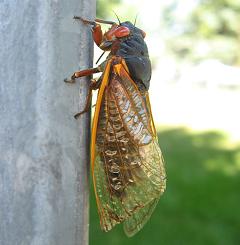You would be surprised at how quickly seventeen years can go by when you’re doing things like reading, watching TV, hanging out, facebook, and partying.
But seriously, the seventeen-year cicadas essentially do the same as the thirteen-year cicadas, they live as larvae a few inches underground, sucking nutrition from the undersides of tree roots.

Entomologists still haven’t figured out the bigger questions about the cicada.
We don’t really know why some of them have an exact odd seventeen-year cycle, while other cicadas operate on an similarly strange thirteen-year cycle. And we don’t know how a huge mass of cicadas manage to emerge at exactly the same time thirteen or seventeen years after they went underground.
What we do know is both of them are prime numbers.
Of course, this strategy of emerging en masse works pretty well for them. As many as 1.5 million cicadas per acre can suddenly appear, overwhelming the ability of their natural predators to eat them.
Their predators like spiders, snakes, rodents, and other animals can feed without putting a big dent in the population, a phenomenon known as predator satiation.
Cicadas are commonly eaten by birds, but fungal disease is the biggest enemy of cicadas. Another known predator is the cicada killer wasp.
After mating, each female lays up to 600 eggs in tree branches, and the cicadas die off as quickly as they appeared.
Ant-like nymphs hatch from the eggs and drop from the tree branches. They burrow into the ground until they find a tree root. After sucking its sap for the next thirteen or seventeen years, they heed some mysterious signal from inside or outside themselves, shed their exoskeletons, and emerge from the ground as cicadas.
Amazing mysteries indeed.
